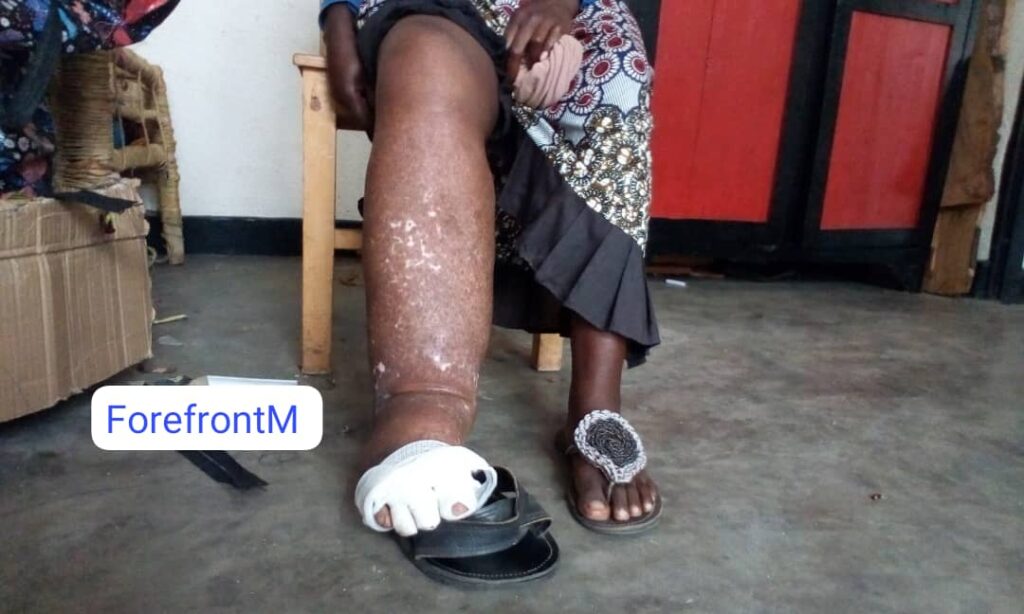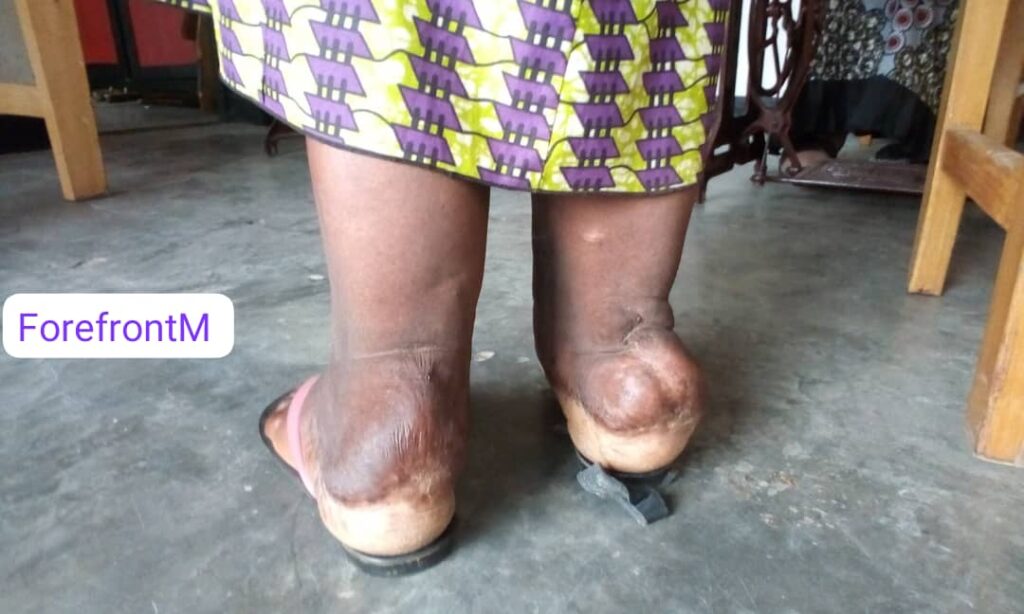By Annonciata Byukusenge
The race to eliminate podoconiosis, a debilitating tropical disease, in Rwanda by 2030 necessitates surmounting challenges ranging from poverty and lack of awareness to gaps in healthcare access.
Musanze is Rwanda’s most mountainous district, containing five of the eight volcanoes that form the Virunga chain in the Volcanoes National Park. Most of Rwanda’s mountain gorillas are found here, making it the country’s most popular tourist destination.
Despite the location’s international appeal, many of Rwanda’s communities are focused on a more local concern. Podoconiosis is a neglected tropical disease marked by swelling of different areas of the body, especially the limbs, and thick, hard skin. People with podoconiosis can become permanently disabled and experience mental, social, and financial distress, further leading to stigma and poverty, according to the World Health Organization.
The Rwanda Biomedical Center says more than 6,000 people across the country have been diagnosed with podoconiosis, which affects four million people worldwide. The condition is often caused by parasitic worms that spread through mosquito bites.
In northern Rwanda, the high concentration of silica in the volcanic soil originating from the Virunga Mountains is the main cause of a form of podoconiosis called podoconiosis. People who are in prolonged contact with the soil such as barefoot children and subsistence farmers are at particular risk, explains Jean Paul Bikorimana, Former Director at Heart and Sole Africa, an NGO working to eliminate elephantiasis. “Mineral salts enter the body through the feet and damage the lymphatic vessels, causing the feet to swell,” he says.
Traditional barriers to treatment
Many residents of Musanze mistake the initial symptoms of podoconiosis as signs of poisoning.
Uwingabire Providence lives in Kinigi village and has suffered from elephantiasis for 11 years. She says the symptoms first showed up when she was a child, leading her parents to consult traditional doctors.
“When I was six years old, I saw many small pimples on one leg, like skin disease, and it was inflamed,” she says. “My parents believed I was poisoned by our neighbors because the pimples were filled with water and caused a lot of pain.
“We tend to think podoconiosis is a poison illness. If you see your kid has pimples on the skin and inflammation, immediately you think that your kid is poisoned.”
“The traditional doctor gave my mother herbal medicines to paint on my leg. These herbs caused infection. After two months, my parents stopped using the medicines and we went to the health centre instead.”
Providence received treatment for the ulcers, but it wasn’t until she was transferred to a hospital offering specialist care for elephantiasis that the condition was finally diagnosed and treated.

“The pain lessened because they gave me pain relievers and medicine,” Providence says. “Now I am recovered, but I have scars on my leg and the swelling hasn’t decreased.”
Mukaneza Jacqueline, 52, suffers from podoconiosis. When she was in primary school, her legs became inflamed. Her parents thought her legs were broken and consulted traditional doctors. Soon, however, they worried that Jacqueline’s condition was the result of poison.
“We tend to think podoconiosis is a poison illness. If you see your kid has pimples on the skin and inflammation, immediately you think that your kid is poisoned,” Jacqueline says, explaining the local belief that only traditional doctors can help in this situation.

Her parents stopped using the traditional medicine after three years, when she was 15, because the swelling didn’t reduce; in fact, it had spread to her knees. Years later, the family consulted doctors at a local hospital, but they were unable to identify the condition. For 30 years, Jacqueline was unable to access treatment.
Aiding access to community care
Podoconiosis is a chronic disease, but it can be treated. “The swelling will decrease, the pain will be reduced, and the person will be able to do their normal activities. Life will continue,” explains Bikorimana.
In 2013, Heart and Sole Africa set up a clinic in Musanze to provide care for podoconiosis patients like Jacqueline. “The doctors helped me with pills that reduced the inflammation, and other lotions to wash my feet with because they had started to become infected,” she says.
An intensive awareness campaign that aims to draw attention to the impacts of elephantiasis and teach local communities about preventative strategies, like wearing shoes to avoid contact with the soil, is also being rolled out.
Munyaribanje Théoneste is another patient at the clinic. He has had podoconiosis for 48 years, and says the treatment has helped decrease the swelling in his legs. The improvement means he can now wear size 37 shoes instead of size 42.
“[When I was a child] my mother used traditional medicines for two years, but the swelling did not decrease. She stopped using these medicines from 1982 until 2017, when I went to the [clinic],” Théoneste says.
“I am a potato farmer. Before 2018 I couldn’t farm because of the swelling in my legs. Now I can wear boots and go to my farm to plant potatoes.
The Musanze clinic has become part of a larger effort to improve access to treatment for people with elephantiasis. In partnership with the Rwanda Biomedical Center, Heart and Sole Africa now works with 11 health treatment centres in Rwanda, with the aim of expanding the service across the country.
An intensive awareness campaign that aims to draw attention to the impacts of elephantiasis and teach local communities about preventative strategies, like wearing shoes to avoid contact with the soil, is also being rolled out.
“In different areas of the country we identified [people with an awareness of] podoconiosis, but the majority in rural areas confuse it with poison,” says Jeanne Uwizeyimana, director of Heart and Sole Africa.
Bikorimana says elephantiasis could be more common among women as they are more likely to take on agricultural work. “Women are dominant in these outdoor occupations, but it is not a disease that only affects women.”
Alongside farmers and other outdoor workers, the campaign targets schools. “Sometimes children don’t like to wear shoes. After informing teachers about the importance of wearing shoes in order to prevent elephantiasis, they will teach the children to always wear shoes,” Uwizeyimana says.
Confronting barriers to elimination
Bikorimana says improving treatment outcomes and awareness of elephantiasis will not be easy as most people who live in the rural areas of Rwanda like Musanze are vulnerable and have very low incomes.
“Poverty is a barrier for implementing these measures. Some of them can afford to start wearing shoes, but others cannot. For example, some families have more than eight kids so, including the father and mother, they are 10. They only eat once per day, so buying shoes is [difficult],” he says.
“Another issue is the need to plaster their house to avoid contact with the ground. Most people living in rural areas are not able to plaster their house.”
Despite the challenges, Bikorimana says Heart and Sole Africa is working towards eliminating podoconiosis in Rwanda by 2030. “By 2024, access to healthcare will reach 95%,” he says. “It is a chronic disease, but it can be treated,” he reiterates.

